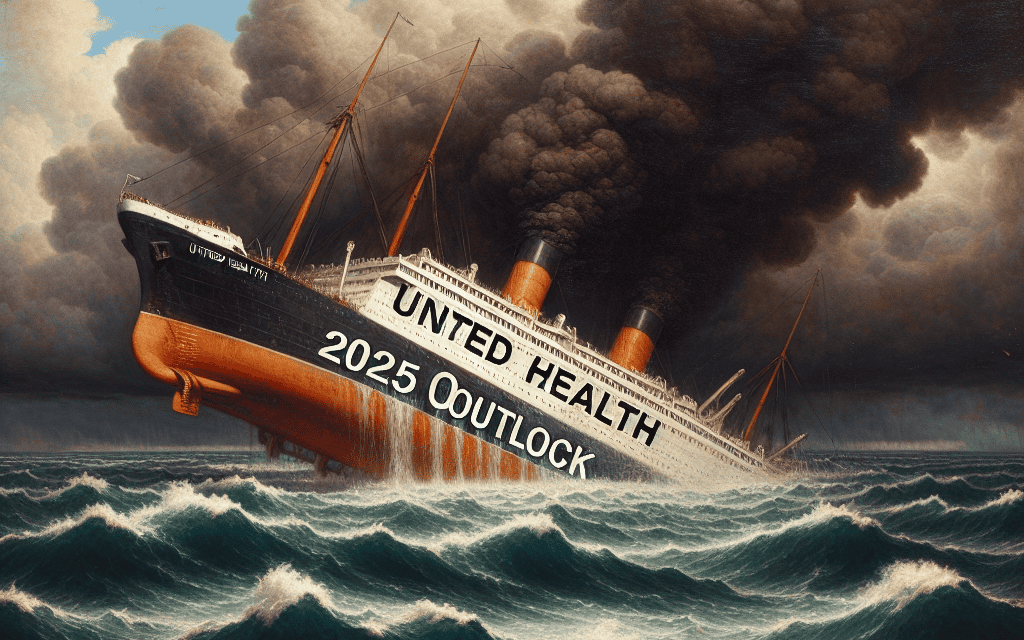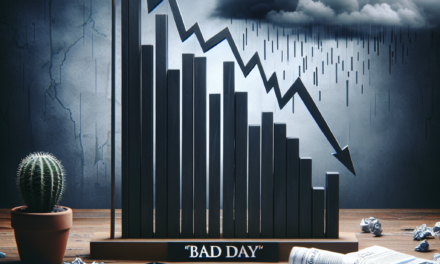“UnitedHealth Stumbles: 2025 Outlook Falls Short, Shares Tumble”
Introduction
UnitedHealth Group, a leading player in the healthcare and insurance sectors, recently experienced a notable decline in its stock value following a rare earnings miss and a disappointing outlook for 2025. The company’s financial performance fell short of market expectations, causing concern among investors and analysts. This unexpected downturn was compounded by a cautious forecast for the coming years, which further dampened investor sentiment. The rare miss in earnings and the tepid future outlook have raised questions about the company’s ability to navigate the evolving healthcare landscape and maintain its growth trajectory. As a result, UnitedHealth’s stock faced significant pressure, reflecting the market’s reaction to the company’s latest financial disclosures.
Analysis Of UnitedHealth’s Rare Earnings Miss And Its Impact On Stock Performance
UnitedHealth Group, a leading player in the healthcare sector, recently experienced a rare setback that has caught the attention of investors and analysts alike. The company’s latest earnings report revealed a miss in its financial targets, a deviation from its usual pattern of consistent performance. This unexpected development has led to a significant decline in UnitedHealth’s stock value, raising questions about the company’s future prospects and the broader implications for the healthcare industry.
The earnings miss was primarily attributed to higher-than-expected medical costs, which have been a growing concern for healthcare providers across the board. As the industry grapples with rising expenses, UnitedHealth’s financial results underscore the challenges of managing costs while maintaining profitability. The company’s inability to meet its earnings expectations has prompted a reevaluation of its strategies and operational efficiencies. Investors, who have long viewed UnitedHealth as a stable and reliable investment, are now reassessing their positions in light of these recent developments.
Adding to the concerns is UnitedHealth’s outlook for 2025, which has been met with disappointment by market participants. The company’s projections for the coming years suggest a more cautious approach, reflecting uncertainties in the healthcare landscape. Factors such as regulatory changes, evolving patient needs, and technological advancements are likely influencing UnitedHealth’s strategic planning. While the company remains a dominant force in the industry, its tempered outlook has raised doubts about its ability to sustain the growth trajectory that investors have come to expect.
The impact of UnitedHealth’s earnings miss and revised outlook extends beyond its own stock performance. As a bellwether for the healthcare sector, UnitedHealth’s financial health is often seen as an indicator of broader industry trends. Consequently, its recent struggles have sparked concerns about the potential ripple effects on other healthcare companies. Investors are now closely monitoring how these developments might influence the strategies and valuations of UnitedHealth’s peers.
In response to the earnings miss, UnitedHealth’s management has emphasized its commitment to addressing the underlying issues and enhancing operational efficiencies. The company is likely to focus on cost management initiatives and explore innovative solutions to mitigate the impact of rising medical expenses. Additionally, UnitedHealth may seek to leverage its extensive data analytics capabilities to optimize patient care and improve outcomes, thereby strengthening its competitive position in the market.
Despite the current challenges, it is important to recognize that UnitedHealth has a strong track record of navigating industry headwinds. The company’s diversified business model, which includes insurance services and healthcare delivery, provides a solid foundation for resilience. Moreover, UnitedHealth’s investments in technology and data-driven solutions position it well to adapt to the evolving healthcare landscape.
In conclusion, UnitedHealth’s rare earnings miss and disappointing 2025 outlook have undoubtedly raised concerns among investors and industry observers. However, the company’s proactive approach to addressing these challenges, coupled with its robust business model, suggests that it is well-equipped to weather the storm. As the healthcare sector continues to evolve, UnitedHealth’s ability to adapt and innovate will be crucial in determining its long-term success. Investors and analysts will be keenly watching how the company navigates this period of uncertainty and positions itself for future growth.
Understanding The Factors Behind UnitedHealth’s Disappointing 2025 Outlook
UnitedHealth Group, a titan in the healthcare industry, recently experienced a rare setback as its financial performance fell short of expectations, causing its stock to sink. This unexpected development has left investors and analysts scrutinizing the factors contributing to the company’s disappointing 2025 outlook. To comprehend the underlying reasons for this rare miss, it is essential to examine the various elements that have influenced UnitedHealth’s current trajectory.
First and foremost, the healthcare sector is inherently complex and subject to a myriad of external pressures. Regulatory changes, fluctuating economic conditions, and evolving consumer demands all play a significant role in shaping the landscape in which UnitedHealth operates. In recent years, the company has navigated these challenges with remarkable agility, consistently delivering robust financial results. However, the current environment presents unique obstacles that have proven difficult to surmount.
One of the primary factors impacting UnitedHealth’s outlook is the ongoing uncertainty surrounding healthcare regulations. With potential policy shifts on the horizon, the company faces the daunting task of adapting to new rules that could significantly alter its operational framework. This regulatory ambiguity creates a challenging environment for long-term strategic planning, as UnitedHealth must remain flexible to accommodate potential changes while striving to maintain its competitive edge.
Moreover, the economic landscape has introduced additional complexities. Inflationary pressures have led to increased costs across various sectors, including healthcare. For UnitedHealth, this translates into higher expenses for medical supplies, pharmaceuticals, and labor. While the company has historically managed cost pressures effectively, the current inflationary environment presents a formidable challenge that could impact its profitability in the coming years.
In addition to these external factors, UnitedHealth must also contend with internal dynamics that influence its performance. The company has made significant investments in technology and innovation to enhance its service offerings and improve operational efficiency. While these initiatives are crucial for long-term growth, they require substantial capital outlay and may not yield immediate returns. Consequently, the financial burden of these investments could weigh on UnitedHealth’s short-term performance, contributing to the less optimistic outlook for 2025.
Furthermore, the competitive landscape in the healthcare industry is intensifying. New entrants and existing players are continually seeking to capture market share by offering innovative solutions and competitive pricing. UnitedHealth, while a leader in the sector, must remain vigilant and proactive in its efforts to differentiate itself from competitors. This necessitates a delicate balance between maintaining profitability and investing in initiatives that drive future growth.
Despite these challenges, it is important to recognize that UnitedHealth possesses several strengths that position it well for long-term success. The company’s extensive network, comprehensive service offerings, and commitment to innovation provide a solid foundation for navigating the complexities of the healthcare industry. Additionally, UnitedHealth’s focus on value-based care and patient-centric solutions aligns with broader industry trends, offering potential avenues for growth and differentiation.
In conclusion, UnitedHealth’s disappointing 2025 outlook can be attributed to a confluence of external and internal factors that have created a challenging operating environment. While the company faces significant hurdles, its strategic initiatives and inherent strengths offer a pathway to recovery and sustained growth. As UnitedHealth continues to adapt to the evolving landscape, its ability to effectively manage regulatory changes, economic pressures, and competitive dynamics will be crucial in shaping its future trajectory.
Investor Reactions To UnitedHealth’s Financial Performance And Future Projections
UnitedHealth Group, a leading player in the healthcare and insurance sectors, recently experienced a significant downturn in its stock value following a rare miss in its quarterly earnings report. This unexpected development has left investors and analysts grappling with the implications of the company’s financial performance and its future projections. The market’s reaction was swift and pronounced, as shares of UnitedHealth sank, reflecting a broader sentiment of disappointment and concern among stakeholders.
The company’s latest earnings report revealed that it fell short of Wall Street’s expectations, a rare occurrence for UnitedHealth, which has consistently delivered robust financial results in the past. This miss was attributed to a combination of factors, including higher-than-anticipated medical costs and increased competition in the healthcare sector. As a result, the company’s profit margins were squeezed, leading to a downward revision of its earnings forecast for the coming quarters.
In addition to the immediate financial miss, UnitedHealth’s outlook for 2025 has also raised eyebrows among investors. The company’s projections for future growth and profitability were less optimistic than anticipated, suggesting potential challenges ahead. This tempered outlook has been attributed to several factors, including regulatory pressures, evolving market dynamics, and the ongoing impact of the COVID-19 pandemic on healthcare utilization patterns. These elements have collectively contributed to a more cautious stance from UnitedHealth’s management regarding the company’s long-term growth trajectory.
The market’s reaction to UnitedHealth’s financial performance and future projections underscores the sensitivity of investors to any signs of weakness in the company’s business model. As a bellwether for the healthcare industry, UnitedHealth’s performance is often seen as an indicator of broader trends within the sector. Consequently, the company’s rare miss and cautious outlook have sparked concerns about the potential ripple effects on other healthcare stocks and the industry as a whole.
Despite the immediate negative reaction, some analysts remain optimistic about UnitedHealth’s ability to navigate these challenges and return to its growth trajectory. They point to the company’s strong fundamentals, diversified business model, and strategic investments in technology and innovation as key factors that could drive future success. Moreover, UnitedHealth’s leadership has emphasized its commitment to adapting to changing market conditions and addressing the evolving needs of its customers.
In light of these developments, investors are closely monitoring UnitedHealth’s strategic initiatives and operational performance in the coming quarters. The company’s ability to effectively manage medical costs, enhance its service offerings, and capitalize on emerging opportunities will be critical in restoring investor confidence and achieving its long-term growth objectives. Additionally, UnitedHealth’s engagement with regulatory bodies and its efforts to influence healthcare policy will play a significant role in shaping its future prospects.
In conclusion, UnitedHealth’s recent financial performance and future projections have elicited a strong reaction from investors, highlighting the challenges and uncertainties facing the company. While the immediate outlook may appear less favorable, the company’s resilience and strategic focus offer a glimmer of hope for a potential rebound. As the healthcare landscape continues to evolve, UnitedHealth’s ability to adapt and innovate will be crucial in determining its success in the years to come. Investors will undoubtedly be watching closely as the company navigates this complex and dynamic environment.
The Role Of Market Conditions In UnitedHealth’s Recent Financial Challenges

UnitedHealth Group, a prominent player in the healthcare sector, recently experienced a notable decline in its stock value following a rare miss in its quarterly earnings report. This unexpected financial performance has raised concerns among investors, particularly as the company’s outlook for 2025 appears less promising than anticipated. To understand the underlying factors contributing to UnitedHealth’s recent financial challenges, it is essential to examine the role of prevailing market conditions and their impact on the company’s operations.
In recent years, the healthcare industry has been navigating a complex landscape characterized by regulatory changes, evolving consumer expectations, and technological advancements. These factors have collectively influenced the operational dynamics of companies like UnitedHealth. However, the current market conditions have introduced additional layers of complexity, which have, in turn, affected UnitedHealth’s financial performance.
One of the primary market conditions impacting UnitedHealth is the increasing cost of healthcare services. As medical expenses continue to rise, insurance providers are under pressure to manage costs while maintaining quality care for their members. This challenge is compounded by the growing demand for personalized and value-based care, which requires significant investment in technology and infrastructure. Consequently, UnitedHealth has had to allocate substantial resources to meet these demands, impacting its profitability.
Moreover, the competitive landscape within the healthcare sector has intensified, with new entrants and existing players vying for market share. This heightened competition has compelled UnitedHealth to innovate continuously and enhance its service offerings to retain its customer base. While innovation is crucial for long-term success, it often involves substantial upfront costs, which can strain financial performance in the short term. As a result, UnitedHealth’s recent earnings miss can be partially attributed to the financial pressures associated with staying competitive in a rapidly evolving market.
In addition to these industry-specific challenges, broader economic conditions have also played a role in UnitedHealth’s financial difficulties. The global economy has been experiencing fluctuations, with factors such as inflation, interest rate changes, and geopolitical tensions contributing to market volatility. These economic uncertainties have affected consumer spending patterns and investment decisions, indirectly impacting companies like UnitedHealth. For instance, inflationary pressures can lead to increased operational costs, while changes in interest rates can influence borrowing costs and investment returns.
Furthermore, regulatory changes continue to shape the healthcare landscape, with policymakers implementing reforms aimed at improving access to care and controlling costs. While these reforms are intended to benefit consumers, they often require healthcare providers to adapt their business models and comply with new regulations. UnitedHealth, like many of its peers, has had to navigate these regulatory shifts, which can be resource-intensive and affect financial performance.
Despite these challenges, UnitedHealth remains a formidable entity within the healthcare sector, with a strong track record of adapting to changing market conditions. The company’s leadership has expressed confidence in its ability to address current challenges and capitalize on future opportunities. However, the disappointing 2025 outlook suggests that UnitedHealth will need to continue refining its strategies to navigate the evolving market landscape effectively.
In conclusion, UnitedHealth’s recent financial challenges can be attributed to a confluence of market conditions, including rising healthcare costs, increased competition, economic uncertainties, and regulatory changes. While these factors have undoubtedly impacted the company’s performance, they also present opportunities for growth and innovation. As UnitedHealth seeks to overcome these hurdles, its ability to adapt and respond to market dynamics will be crucial in shaping its future trajectory.
Comparing UnitedHealth’s Performance With Competitors In The Healthcare Sector
UnitedHealth Group, a prominent player in the healthcare sector, recently experienced a notable decline in its stock value following a rare earnings miss and a disappointing outlook for 2025. This development has prompted investors and analysts to scrutinize the company’s performance in comparison to its competitors within the industry. Understanding how UnitedHealth stacks up against its peers is crucial for stakeholders seeking to navigate the complexities of the healthcare market.
To begin with, UnitedHealth’s recent performance can be attributed to several factors, including rising medical costs and regulatory challenges. These issues have not only impacted UnitedHealth but have also been a concern for other major healthcare companies. However, the degree to which these factors affect each company varies, leading to differing financial outcomes. For instance, while UnitedHealth has faced challenges, competitors such as Anthem and Cigna have managed to maintain relatively stable financial performances. This disparity highlights the importance of strategic management and adaptability in the face of industry-wide challenges.
Moreover, UnitedHealth’s diversified business model, which includes both insurance services and healthcare provision through its Optum segment, has traditionally been a strength. However, in the current climate, this diversification has not insulated the company from market pressures as effectively as anticipated. In contrast, companies like Humana, which have a more focused approach primarily on Medicare Advantage plans, have been able to leverage their specialization to achieve more favorable outcomes. This comparison underscores the significance of strategic focus and market positioning in navigating the healthcare landscape.
In addition to strategic considerations, technological advancements and innovation play a pivotal role in determining a company’s competitive edge. UnitedHealth has invested significantly in technology to enhance its service delivery and operational efficiency. Nevertheless, competitors such as CVS Health have also made substantial strides in integrating technology into their healthcare offerings, particularly through their acquisition of Aetna and expansion into telehealth services. This competitive dynamic illustrates the ongoing race among healthcare giants to harness technology as a means of differentiation and value creation.
Furthermore, regulatory changes and policy shifts continue to shape the healthcare sector, influencing the performance of companies like UnitedHealth and its competitors. The evolving landscape of healthcare regulations, particularly in the United States, presents both challenges and opportunities. Companies that can adeptly navigate these changes, such as Centene with its focus on government-sponsored healthcare programs, often find themselves better positioned to capitalize on new market opportunities. This regulatory environment necessitates a proactive approach to compliance and strategic planning, which can significantly impact a company’s financial health and market standing.
In conclusion, UnitedHealth’s recent struggles, marked by a rare earnings miss and a less-than-optimistic outlook for 2025, have brought to light the competitive dynamics within the healthcare sector. By comparing UnitedHealth’s performance with that of its competitors, it becomes evident that strategic focus, technological innovation, and regulatory adaptability are key determinants of success in this industry. As the healthcare landscape continues to evolve, companies must remain vigilant and responsive to both internal and external pressures to maintain their competitive edge. For investors and stakeholders, understanding these dynamics is essential for making informed decisions in a sector characterized by complexity and rapid change.
Strategic Adjustments UnitedHealth Might Consider Following The Earnings Miss
UnitedHealth Group, a titan in the healthcare industry, recently experienced a rare setback as its earnings report fell short of expectations, causing a notable dip in its stock value. This unexpected miss, coupled with a less-than-optimistic outlook for 2025, has prompted analysts and stakeholders to consider strategic adjustments that the company might undertake to regain its footing. As the healthcare landscape continues to evolve, UnitedHealth’s ability to adapt and innovate will be crucial in maintaining its competitive edge.
One potential area for strategic adjustment is the enhancement of UnitedHealth’s technological infrastructure. In recent years, the healthcare sector has increasingly embraced digital solutions to improve patient care and streamline operations. By investing in advanced technologies such as artificial intelligence and machine learning, UnitedHealth could enhance its data analytics capabilities, leading to more personalized and efficient healthcare services. This technological advancement would not only improve patient outcomes but also reduce operational costs, thereby positively impacting the company’s financial performance.
Moreover, UnitedHealth might consider expanding its telehealth services, which have gained significant traction during the COVID-19 pandemic. Telehealth offers a convenient and cost-effective alternative to traditional in-person consultations, and its popularity is expected to continue growing. By strengthening its telehealth offerings, UnitedHealth can tap into new revenue streams and cater to the increasing demand for remote healthcare services. This strategic move would also align with the broader industry trend towards digital health solutions, positioning UnitedHealth as a leader in this rapidly expanding market.
In addition to technological advancements, UnitedHealth could benefit from diversifying its service portfolio. The healthcare industry is multifaceted, with numerous opportunities for growth in areas such as mental health, chronic disease management, and preventive care. By broadening its range of services, UnitedHealth can address unmet needs in the market and attract a wider customer base. This diversification strategy would not only mitigate risks associated with reliance on a limited set of services but also enhance the company’s resilience in the face of economic fluctuations.
Furthermore, UnitedHealth might explore strategic partnerships and acquisitions to bolster its market position. Collaborating with innovative startups or acquiring companies with complementary capabilities could provide UnitedHealth with access to new technologies, expertise, and customer segments. Such partnerships could accelerate the company’s growth and enable it to offer more comprehensive and integrated healthcare solutions. By leveraging synergies with other industry players, UnitedHealth can enhance its value proposition and strengthen its competitive advantage.
Another critical aspect for UnitedHealth to consider is optimizing its cost structure. In an industry characterized by rising costs and regulatory pressures, maintaining operational efficiency is paramount. UnitedHealth could conduct a thorough review of its expenses and identify areas where cost savings can be achieved without compromising the quality of care. Implementing lean management practices and optimizing supply chain operations could result in significant cost reductions, thereby improving the company’s profitability.
In conclusion, UnitedHealth’s recent earnings miss and disappointing 2025 outlook serve as a wake-up call for the company to reassess its strategic direction. By embracing technological advancements, expanding its service portfolio, pursuing strategic partnerships, and optimizing its cost structure, UnitedHealth can navigate the challenges ahead and emerge stronger. As the healthcare industry continues to transform, UnitedHealth’s ability to adapt and innovate will be key to sustaining its leadership position and delivering value to its stakeholders.
Long-term Implications Of UnitedHealth’s 2025 Outlook On The Healthcare Industry
UnitedHealth Group, a titan in the healthcare industry, recently experienced a rare setback as its financial performance fell short of expectations, causing its stock to sink. This unexpected miss, coupled with a disappointing outlook for 2025, has sent ripples through the healthcare sector, prompting analysts and investors to reassess the long-term implications for the industry. As the largest health insurer in the United States, UnitedHealth’s performance is often seen as a bellwether for the broader healthcare market. Therefore, its recent struggles have raised questions about the future trajectory of the industry and the potential challenges that lie ahead.
To begin with, UnitedHealth’s rare miss can be attributed to several factors, including rising medical costs and increased competition. The company has faced mounting pressure to manage expenses while maintaining quality care, a challenge that is not unique to UnitedHealth but is emblematic of broader industry trends. As healthcare costs continue to rise, insurers are grappling with the need to balance affordability with profitability. This delicate balancing act is further complicated by the entry of new players into the market, which has intensified competition and put additional pressure on established companies like UnitedHealth.
Moreover, the disappointing 2025 outlook has raised concerns about the sustainability of growth in the healthcare sector. UnitedHealth’s projections suggest that the company anticipates slower growth in the coming years, a sentiment that may be reflective of broader industry dynamics. This outlook has prompted stakeholders to consider the potential long-term implications for the healthcare industry, particularly in terms of innovation and investment. As growth prospects become more uncertain, companies may be less inclined to invest in new technologies and services, which could stifle innovation and limit advancements in patient care.
In addition to these challenges, regulatory changes and policy shifts are likely to play a significant role in shaping the future of the healthcare industry. With ongoing debates about healthcare reform and the potential for new regulations, companies like UnitedHealth must navigate an increasingly complex landscape. These regulatory uncertainties can impact strategic planning and decision-making, further complicating efforts to achieve sustainable growth. As policymakers continue to grapple with issues such as access to care and cost containment, the healthcare industry must remain agile and adaptable to respond to these evolving challenges.
Furthermore, the implications of UnitedHealth’s outlook extend beyond the company itself, affecting a wide range of stakeholders, including patients, providers, and investors. For patients, the potential for slower growth and increased competition could lead to changes in the availability and affordability of healthcare services. Providers may also face pressures to deliver high-quality care while managing costs, necessitating new approaches to care delivery and collaboration. Investors, on the other hand, may need to reassess their strategies and expectations for returns in the healthcare sector, taking into account the potential for increased volatility and uncertainty.
In conclusion, UnitedHealth’s recent financial performance and 2025 outlook have significant long-term implications for the healthcare industry. As the sector navigates rising costs, increased competition, and regulatory uncertainties, stakeholders must remain vigilant and proactive in addressing these challenges. By fostering innovation, adapting to policy changes, and prioritizing patient care, the healthcare industry can work towards a more sustainable and resilient future. While the road ahead may be fraught with challenges, it also presents opportunities for growth and transformation, ultimately benefiting all those who rely on the healthcare system.
Q&A
1. **What happened to UnitedHealth’s stock?**
UnitedHealth’s stock sank following a rare earnings miss.
2. **What was the reason for the stock decline?**
The decline was due to a disappointing outlook for 2025.
3. **How often does UnitedHealth miss earnings expectations?**
It is rare for UnitedHealth to miss earnings expectations.
4. **What specific aspect of the outlook was disappointing?**
The specific details of the disappointing outlook were not provided, but it generally relates to future financial performance.
5. **How did investors react to the news?**
Investors reacted negatively, leading to a drop in the stock price.
6. **What is the significance of the 2025 outlook?**
The 2025 outlook is significant as it provides guidance on the company’s expected future performance, influencing investor confidence.
7. **What might UnitedHealth do in response to the stock decline?**
UnitedHealth might review its strategies and communicate plans to address investor concerns, although specific actions were not detailed.
Conclusion
UnitedHealth’s stock decline following a rare earnings miss and a disappointing 2025 outlook highlights investor concerns about the company’s future growth prospects. The miss suggests potential challenges in managing costs or achieving expected revenue targets, while the underwhelming outlook for 2025 may indicate anticipated difficulties in navigating market dynamics or regulatory changes. This situation underscores the importance of strategic adjustments to restore investor confidence and align future performance with market expectations.





